
IBM Unveils Latest Quantum Processor and IBM Quantum System Two, Expands Plan to Propel the Quantum Utility Era Forward

By Brian K. Neal
IBM Quantum Heron marks the inception of a groundbreaking series of utility-scale quantum processors. This innovative architecture, meticulously engineered over a four-year span, sets new standards for IBM, delivering unparalleled performance metrics and the lowest error rates among all IBM Quantum processors to date.
In conjunction with this milestone, IBM introduced the IBM Quantum System Two, a modular quantum computer that serves as the cornerstone of IBM’s quantum-centric supercomputing architecture. The inaugural IBM Quantum System Two, operational in Yorktown Heights, New York, features three IBM Heron processors accompanied by supporting control electronics. This foundational setup, coupled with breakthroughs in quantum hardware, theory, and software, has prompted IBM to extend its Quantum Development Roadmap to 2033. The roadmap outlines ambitious targets to advance the quality of gate operations, enabling the execution of larger quantum circuits and unlocking the full potential of quantum computing at scale.
Dario Gil, IBM’s Senior Vice President and Director of Research, emphasized the transformative era in which quantum computers are evolving into tools for exploring new scientific frontiers. The focus on modular architectures and scalable quantum systems aims to enhance the quality of utility-scale quantum technology stacks, empowering users and partners to tackle increasingly complex problems.
Building on the success of the 127-qubit ‘IBM Quantum Eagle’ processor earlier this year, IBM Quantum systems have demonstrated their utility in exploring large-scale problems in chemistry, physics, and materials. Collaborations with leading researchers and organizations worldwide, including the U.S. Department of Energy’s Argonne National Laboratory, Harvard University, and others, have expanded the scope of utility-scale quantum computing, affirming its value in uncharted computational territory.
The IBM Quantum Heron 133-qubit processor, featuring significantly improved error rates, is now available to users through the cloud. This processor, the first in a new class of performant processors, boasts a five-fold improvement in error rates compared to its predecessor, the IBM Eagle. In the coming year, additional IBM Heron processors will join the company’s utility-scale fleet of quantum systems.
IBM Quantum System Two serves as the foundation for IBM’s next-generation quantum computing system architecture. Combining scalable cryogenic infrastructure, classical runtime servers, and modular qubit control electronics, this system is integral to IBM’s vision of quantum-centric supercomputing. The architecture seamlessly integrates quantum communication and computation with classical computing resources, leveraging a middleware layer to harmonize quantum and classical workflows.

As part of the expanded ten-year IBM Quantum Development Roadmap, future generations of quantum processors will reside in the IBM Quantum System Two, gradually improving the quality of operations and expanding the capability to handle increasingly complex workloads.
In tandem with these hardware advancements, IBM details plans for a new generation of its software stack. Qiskit 1.0 serves as a pivotal point defined by stability and speed, while the introduction of Qiskit Patterns aims to simplify quantum code creation for developers. This mechanism, combined with Quantum Serverless, enables the seamless building, deployment, and execution of workflows that integrate classical and quantum computation across various environments, such as cloud or on-premises scenarios.
IBM is also pioneering the use of generative AI for quantum code programming through watsonx, the enterprise AI platform. Generative AI available through watsonx will automate the development of quantum code for Qiskit, utilizing the fine-tuned IBM Granite model series. This strategic integration aims to simplify the accessibility of quantum computing, allowing users to harness it as a powerful instrument for scientific exploration.
With advanced hardware and user-friendly software, IBM’s global fleet of 100+ qubit systems empowers users and computational scientists to obtain reliable results from quantum systems. This holistic approach enables the mapping of increasingly larger and more complex problems to quantum circuits, unlocking new possibilities for scientific discovery.







